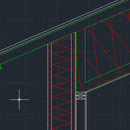Dense-packed cellulose wall insulation
Hi everyone, bit of theoretical question here. Could a wall be designed that would allow cellulose to be blown in at a lower density than “dense-packed” and any settling that will occur is accounted for in the design? (see below). Obviously cavities below windows would need to dense packed. I guess what I am asking here is does dense packing improve wall performance in other ways other than R-value vs loose filled?
Thank you
GBA Detail Library
A collection of one thousand construction details organized by climate and house part










Replies
Oliver,
1. If you built the wall shown in your drawing, and the cellulose settled, the flaw at the top of the wall would reduce the effectiveness of your thermal envelope, and you would have more heat loss in this location than is desirable.
2. To answer your question, "Does dense packing improve wall performance in other ways other than R-value vs. loose filled?": Yes. Dense packing reduces the chance of air flow through the insulation or the possibility of a convection loop. Moreover, elimination of settling is itself a valuable characteristic of this method.
For more information, see How to Install Cellulose Insulation.
Also, if it is a two story house, the approach shown is only applicable to the second story, because fire code prohibits having the the cavity extend unbroken over more than one floor.
Interesting idea, though.
I think it would be hard to avoid uneven settlement. You could end up with voids in various places, not just at the top. I also doubt you'd save much money.
Damp sprayed cellulose doesn't tend to settle even at 1.5-2.5 lbs dry-density, due to the water activated adhesives.
It's not as air retardent as 3.5lb cellulose, but it's still a lot more air retardent than R20 batts and WAY more air retardent than 1.0lb density blown fiberglass (which is still a standard listed blowing density for some products)
I think Robert Riversong used to leave the tops of his truss-like walls open so that any settling would be compensated for by stealing from the attic. One of many unusual details. It would be interesting to see how those places have stood up over time.
I have the same curiosity. The fact that his designs typically use ship-lap siding with the cellulose tight to the siding (no intervening sheathing layers) means the moisture cycling of the cellulose is likely higher than in some other designs. He at least uses air tight wallboard and vapor retardent paints.
He tends to build houses with roof overhangs of about 1' per story, which limits the direct wetting. But by his own accounting that isn't part of the moisture management design. (I suspect it's more important to his designs than he seems to think it is. )
In defense of the practice he has also suggested that:
"Softwood lap siding has a vapor permeance of between 10 and 35 - with solid-color latex stain on both sides, about 5 perm."
Those vapor permeance numbers are dubious to this observer. Though I don't have a good reference for the actual vapor permeance of 3/4" thick plank, I suspect it's about an order of magnitude lower. Dry framing lumber tends to run about the same vapor permeance as closed cell foam, on the order of 1 perm @ 1". Even 3/4" asphalted fiberboard isn't more than about 20 perms under very high humidity conditions, and I would expect solid plank to run much lower than fiberboard. Most 3/4" plywood doesn't break 10 perms until the RH has been a stable 65% or higher for an extended period of time, which is the threshold of mold territory.
Dana,
I have a table that I saved a long time ago -- unfortunately I failed to note the source.
The table lists the permeance of a "3/4 inch wood board" as 0.30-4.03 perms (grain/ft²hr (in.Hg)).
Thanks Martin!
That sounds more like the range I would expect- higher permeance when the moisture content and/or RH is high, but pretty vapor tight when dry.